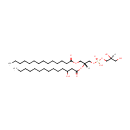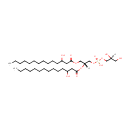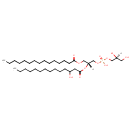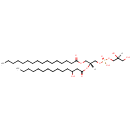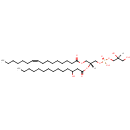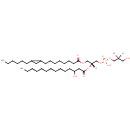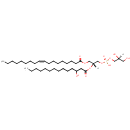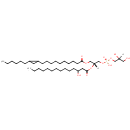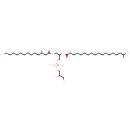
Search Results for compounds
Searching compounds for
returned 4373 results.
Displaying compounds 2231 - 2240 of
4373 in total
PG(14:0(3-OH)/14:0) (PAMDB004061)
IUPAC:
[(2S)-2,3-dihydroxypropoxy][(2R)-2-[(3-hydroxytetradecanoyl)oxy]-3-(tetradecanoyloxy)propoxy]phosphinic acid
CAS: Not Available
Description: PG(14:0(3-OH)/14:0) is a phosphatidylglycerol. Phosphatidylglycerols consist of a glycerol 3-phosphate backbone esterified to either saturated or unsaturated fatty acids on carbons 1 and 2. As is the case with diacylglycerols, phosphatidylglycerols can have many different combinations of fatty acids of varying lengths and saturation attached to the C-1 and C-2 positions. PG(14:0(3-OH)/14:0), in particular, consists of one 3-hydroxytetradecanoyl chain to the C-1 atom, and one tetradecanoyl to the C-2 atom. In Pseudomonas aeruginosa glycerophospholipid metabolism, phosphatidylglycerol is formed from phosphatidic acid (1,2-diacyl-sn-glycerol 3-phosphate) by a sequence of enzymatic reactions that proceeds via two intermediates, cytidine diphosphate diacylglycerol (CDP-diacylglycerol) and phosphatidylglycerophosphate (PGP, a phosphorylated phosphatidylglycerol). Phosphatidylglycerols, along with CDP-diacylglycerol, also serve as precursor molecules for the synthesis of cardiolipin, a phospholipid found in membranes.
PG(14:0(3-OH)/14:0(3-OH)) (PAMDB004062)
IUPAC:
[(2R)-2,3-bis[(3-hydroxytetradecanoyl)oxy]propoxy][(2S)-2,3-dihydroxypropoxy]phosphinic acid
CAS: Not Available
Description: PG(14:0(3-OH)/14:0(3-OH)) is a phosphatidylglycerol. Phosphatidylglycerols consist of a glycerol 3-phosphate backbone esterified to either saturated or unsaturated fatty acids on carbons 1 and 2. As is the case with diacylglycerols, phosphatidylglycerols can have many different combinations of fatty acids of varying lengths and saturation attached to the C-1 and C-2 positions. PG(14:0(3-OH)/14:0(3-OH)), in particular, consists of two 3-hydroxytetradecanoyl chains at positions C-1 and C-2. In Pseudomonas aeruginosa glycerophospholipid metabolism, phosphatidylglycerol is formed from phosphatidic acid (1,2-diacyl-sn-glycerol 3-phosphate) by a sequence of enzymatic reactions that proceeds via two intermediates, cytidine diphosphate diacylglycerol (CDP-diacylglycerol) and phosphatidylglycerophosphate (PGP, a phosphorylated phosphatidylglycerol). Phosphatidylglycerols, along with CDP-diacylglycerol, also serve as precursor molecules for the synthesis of cardiolipin, a phospholipid found in membranes.
PG(14:0(3-OH)/15:0) (PAMDB004063)
IUPAC:
[(2S)-2,3-dihydroxypropoxy][(2R)-2-[(3-hydroxytetradecanoyl)oxy]-3-(pentadecanoyloxy)propoxy]phosphinic acid
CAS: Not Available
Description: PG(14:0(3-OH)/15:0) is a phosphatidylglycerol. Phosphatidylglycerols consist of a glycerol 3-phosphate backbone esterified to either saturated or unsaturated fatty acids on carbons 1 and 2. As is the case with diacylglycerols, phosphatidylglycerols can have many different combinations of fatty acids of varying lengths and saturation attached to the C-1 and C-2 positions. PG(14:0(3-OH)/15:0), in particular, consists of one 3-hydroxytetradecanoyl chain to the C-1 atom, and one pentadecanoyl to the C-2 atom. In Pseudomonas aeruginosa glycerophospholipid metabolism, phosphatidylglycerol is formed from phosphatidic acid (1,2-diacyl-sn-glycerol 3-phosphate) by a sequence of enzymatic reactions that proceeds via two intermediates, cytidine diphosphate diacylglycerol (CDP-diacylglycerol) and phosphatidylglycerophosphate (PGP, a phosphorylated phosphatidylglycerol). Phosphatidylglycerols, along with CDP-diacylglycerol, also serve as precursor molecules for the synthesis of cardiolipin, a phospholipid found in membranes.
PG(14:0(3-OH)/15:0cyclo) (PAMDB004064)
IUPAC:
[(2R)-3-{[8-(2-butylcyclopropyl)octanoyl]oxy}-2-[(3-hydroxytetradecanoyl)oxy]propoxy][(2S)-2,3-dihydroxypropoxy]phosphinic acid
CAS: Not Available
Description: PG(14:0(3-OH)/15:0cyclo) is a phosphatidylglycerol. Phosphatidylglycerols consist of a glycerol 3-phosphate backbone esterified to either saturated or unsaturated fatty acids on carbons 1 and 2. As is the case with diacylglycerols, phosphatidylglycerols can have many different combinations of fatty acids of varying lengths and saturation attached to the C-1 and C-2 positions. PG(14:0(3-OH)/15:0cyclo), in particular, consists of one 3-hydroxytetradecanoyl chain to the C-1 atom, and one cis-9,10-Methylenetetradecanoic acid to the C-2 atom. In Pseudomonas aeruginosa glycerophospholipid metabolism, phosphatidylglycerol is formed from phosphatidic acid (1,2-diacyl-sn-glycerol 3-phosphate) by a sequence of enzymatic reactions that proceeds via two intermediates, cytidine diphosphate diacylglycerol (CDP-diacylglycerol) and phosphatidylglycerophosphate (PGP, a phosphorylated phosphatidylglycerol). Phosphatidylglycerols, along with CDP-diacylglycerol, also serve as precursor molecules for the synthesis of cardiolipin, a phospholipid found in membranes.
PG(14:0(3-OH)/16:0) (PAMDB004065)
IUPAC:
[(2S)-2,3-dihydroxypropoxy][(2R)-3-(hexadecanoyloxy)-2-[(3-hydroxytetradecanoyl)oxy]propoxy]phosphinic acid
CAS: Not Available
Description: PG(14:0(3-OH)/16:0) is a phosphatidylglycerol. Phosphatidylglycerols consist of a glycerol 3-phosphate backbone esterified to either saturated or unsaturated fatty acids on carbons 1 and 2. As is the case with diacylglycerols, phosphatidylglycerols can have many different combinations of fatty acids of varying lengths and saturation attached to the C-1 and C-2 positions. PG(14:0(3-OH)/16:0), in particular, consists of one 3-hydroxytetradecanoyl chain to the C-1 atom, and one hexadecanoyl to the C-2 atom. In Pseudomonas aeruginosa glycerophospholipid metabolism, phosphatidylglycerol is formed from phosphatidic acid (1,2-diacyl-sn-glycerol 3-phosphate) by a sequence of enzymatic reactions that proceeds via two intermediates, cytidine diphosphate diacylglycerol (CDP-diacylglycerol) and phosphatidylglycerophosphate (PGP, a phosphorylated phosphatidylglycerol). Phosphatidylglycerols, along with CDP-diacylglycerol, also serve as precursor molecules for the synthesis of cardiolipin, a phospholipid found in membranes.
PG(14:0(3-OH)/16:1(9Z)) (PAMDB004066)
IUPAC:
[(2S)-2,3-dihydroxypropoxy][(2R)-3-[(9Z)-hexadec-9-enoyloxy]-2-[(3-hydroxytetradecanoyl)oxy]propoxy]phosphinic acid
CAS: Not Available
Description: PG(14:0(3-OH)/16:1(9Z)) is a phosphatidylglycerol. Phosphatidylglycerols consist of a glycerol 3-phosphate backbone esterified to either saturated or unsaturated fatty acids on carbons 1 and 2. As is the case with diacylglycerols, phosphatidylglycerols can have many different combinations of fatty acids of varying lengths and saturation attached to the C-1 and C-2 positions. PG(14:0(3-OH)/16:1(9Z)), in particular, consists of one 3-hydroxytetradecanoyl chain to the C-1 atom, and one 9Z-hexadecenoyl to the C-2 atom. In Pseudomonas aeruginosa glycerophospholipid metabolism, phosphatidylglycerol is formed from phosphatidic acid (1,2-diacyl-sn-glycerol 3-phosphate) by a sequence of enzymatic reactions that proceeds via two intermediates, cytidine diphosphate diacylglycerol (CDP-diacylglycerol) and phosphatidylglycerophosphate (PGP, a phosphorylated phosphatidylglycerol). Phosphatidylglycerols, along with CDP-diacylglycerol, also serve as precursor molecules for the synthesis of cardiolipin, a phospholipid found in membranes.
PG(14:0(3-OH)/17:0cycw7c) (PAMDB004067)
IUPAC:
[(2S)-2,3-dihydroxypropoxy][(2R)-3-{[8-(2-hexylcyclopropyl)octanoyl]oxy}-2-[(3-hydroxytetradecanoyl)oxy]propoxy]phosphinic acid
CAS: Not Available
Description: PG(14:0(3-OH)/17:0cycw7c) is a phosphatidylglycerol. Phosphatidylglycerols consist of a glycerol 3-phosphate backbone esterified to either saturated or unsaturated fatty acids on carbons 1 and 2. As is the case with diacylglycerols, phosphatidylglycerols can have many different combinations of fatty acids of varying lengths and saturation attached to the C-1 and C-2 positions. PG(14:0(3-OH)/17:0cycw7c), in particular, consists of one 3-hydroxytetradecanoyl chain to the C-1 atom, and one heptadec-9-10-cyclo-anoyl to the C-2 atom. In Pseudomonas aeruginosa glycerophospholipid metabolism, phosphatidylglycerol is formed from phosphatidic acid (1,2-diacyl-sn-glycerol 3-phosphate) by a sequence of enzymatic reactions that proceeds via two intermediates, cytidine diphosphate diacylglycerol (CDP-diacylglycerol) and phosphatidylglycerophosphate (PGP, a phosphorylated phosphatidylglycerol). Phosphatidylglycerols, along with CDP-diacylglycerol, also serve as precursor molecules for the synthesis of cardiolipin, a phospholipid found in membranes.
PG(14:0(3-OH)/18:1(9Z)) (PAMDB004068)
IUPAC:
[(2S)-2,3-dihydroxypropoxy][(2R)-2-[(3-hydroxytetradecanoyl)oxy]-3-[(9Z)-octadec-9-enoyloxy]propoxy]phosphinic acid
CAS: Not Available
Description: PG(14:0(3-OH)/18:1(9Z)) is a phosphatidylglycerol. Phosphatidylglycerols consist of a glycerol 3-phosphate backbone esterified to either saturated or unsaturated fatty acids on carbons 1 and 2. As is the case with diacylglycerols, phosphatidylglycerols can have many different combinations of fatty acids of varying lengths and saturation attached to the C-1 and C-2 positions. PG(14:0(3-OH)/18:1(9Z)), in particular, consists of one 3-hydroxytetradecanoyl chain to the C-1 atom, and one 9Z-octadecenoyl to the C-2 atom. In Pseudomonas aeruginosa glycerophospholipid metabolism, phosphatidylglycerol is formed from phosphatidic acid (1,2-diacyl-sn-glycerol 3-phosphate) by a sequence of enzymatic reactions that proceeds via two intermediates, cytidine diphosphate diacylglycerol (CDP-diacylglycerol) and phosphatidylglycerophosphate (PGP, a phosphorylated phosphatidylglycerol). Phosphatidylglycerols, along with CDP-diacylglycerol, also serve as precursor molecules for the synthesis of cardiolipin, a phospholipid found in membranes.
PG(14:0(3-OH)/19:0cycv8c) (PAMDB004069)
IUPAC:
[(2S)-2,3-dihydroxypropoxy][(2R)-3-{[10-(2-hexylcyclopropyl)decanoyl]oxy}-2-[(3-hydroxytetradecanoyl)oxy]propoxy]phosphinic acid
CAS: Not Available
Description: PG(14:0(3-OH)/19:0cycv8c) is a phosphatidylglycerol. Phosphatidylglycerols consist of a glycerol 3-phosphate backbone esterified to either saturated or unsaturated fatty acids on carbons 1 and 2. As is the case with diacylglycerols, phosphatidylglycerols can have many different combinations of fatty acids of varying lengths and saturation attached to the C-1 and C-2 positions. PG(14:0(3-OH)/19:0cycv8c), in particular, consists of one 3-hydroxytetradecanoyl chain to the C-1 atom, and one heptadec-11-12-cyclo-anoyl to the C-2 atom. In Pseudomonas aeruginosa glycerophospholipid metabolism, phosphatidylglycerol is formed from phosphatidic acid (1,2-diacyl-sn-glycerol 3-phosphate) by a sequence of enzymatic reactions that proceeds via two intermediates, cytidine diphosphate diacylglycerol (CDP-diacylglycerol) and phosphatidylglycerophosphate (PGP, a phosphorylated phosphatidylglycerol). Phosphatidylglycerols, along with CDP-diacylglycerol, also serve as precursor molecules for the synthesis of cardiolipin, a phospholipid found in membranes.
PG(14:0(3-OH)/19:iso) (PAMDB004070)
IUPAC:
(2,3-dihydroxypropoxy)({3-[(3-hydroxytetradecanoyl)oxy]-2-[(17-methyloctadecanoyl)oxy]propoxy})phosphinic acid
CAS: Not Available
Description: PG(14:0(3-OH)/19:iso) is a phosphatidylglycerol. Phosphatidylglycerols consist of a glycerol 3-phosphate backbone esterified to either saturated or unsaturated fatty acids on carbons 1 and 2. As is the case with diacylglycerols, phosphatidylglycerols can have many different combinations of fatty acids of varying lengths and saturation attached to the C-1 and C-2 positions. PG(14:0(3-OH)/19:iso), in particular, consists of one 3-hydroxytetradecanoyl chain to the C-1 atom, and one 17-methylocatdecanoyl to the C-2 atom. In Pseudomonas aeruginosa glycerophospholipid metabolism, phosphatidylglycerol is formed from phosphatidic acid (1,2-diacyl-sn-glycerol 3-phosphate) by a sequence of enzymatic reactions that proceeds via two intermediates, cytidine diphosphate diacylglycerol (CDP-diacylglycerol) and phosphatidylglycerophosphate (PGP, a phosphorylated phosphatidylglycerol). Phosphatidylglycerols, along with CDP-diacylglycerol, also serve as precursor molecules for the synthesis of cardiolipin, a phospholipid found in membranes.
